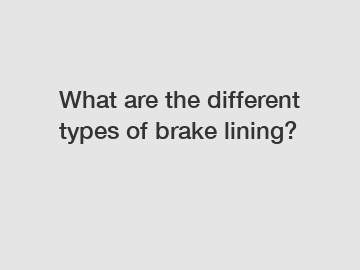Dec. 26, 2023
Automobiles & Motorcycles
Link to ALLMAX
What are the different types of brake lining?
When it comes to braking systems, the brake lining is a critical component that plays a vital role in ensuring safe and effective braking. Brake linings are designed to provide friction against the brake drum or disc when the brakes are applied, generating the necessary stopping force. As such, there are various types of brake linings available that cater to different needs and requirements. In this article, we will explore the different types of brake linings, their origins, the process of their development, as well as their significance and impact in the automotive industry.

As technology advances, manufacturers have developed different types of brake linings to meet the diverse demands of vehicles and driving conditions. One common type is organic brake linings, also known as non-asbestos organic (NAO) linings. These linings are composed of a mixture of organic fibers, fillers, and binding agents. Organic brake linings are widely used due to their affordability, low noise level, and smooth braking performance. However, they tend to wear out faster and generate more dust compared to other types.
Another type of brake lining is the semi-metallic lining, which combines organic fibers with metal particles such as steel or copper. These linings offer better heat dissipation and durability compared to organic linings. They also provide improved braking performance, especially under high-speed and heavy-duty driving conditions. However, semi-metallic linings tend to generate more noise and wear the brake drum or disc faster, which may necessitate more frequent replacements.
In recent years, ceramic brake linings have gained popularity due to their superior performance characteristics. These linings are made from a mixture of ceramic fibers, nonferrous filler materials, and binding agents. Ceramic brake linings offer exceptional braking power, even in high-temperature situations. They also provide a quieter and smoother braking experience, produce less dust, and have a longer lifespan compared to organic or semi-metallic linings. However, they are typically more expensive and may not be suitable for all vehicles and driving situations.
The development and selection of brake linings involve a thorough process of research, testing, and evaluation. Manufacturers consider various factors such as braking efficiency, durability, noise generation, heat dissipation, cost, and environmental impact. Extensive laboratory and real-world testing are conducted to ensure that brake linings meet safety standards and performance requirements. This process ensures that vehicles can stop effectively and reliably under a wide range of operating conditions, enhancing overall safety on the roads.
In conclusion, the different types of brake linings available include organic, semi-metallic, and ceramic linings. Each type offers varying benefits and trade-offs in terms of cost, performance, durability, and noise generation. The selection of brake lining is a critical decision that should consider the specific needs and requirements of the vehicle and driving conditions. With continued advancements in technology and materials, brake linings will continue to evolve, further improving braking performance and ensuring safer journeys for all.
If you are looking for more details, kindly visit bpw brake pads.
If you are interested in sending in a Guest Blogger Submission,welcome to write for us!
All Comments ( 0 )